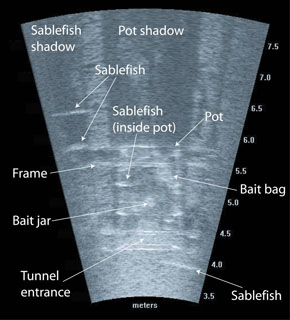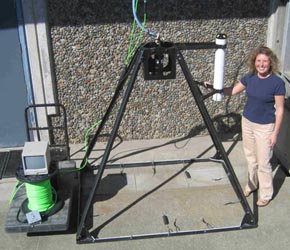Newport Laboratory
Fish Behavior and the Performance of Baited Fishing Gear
| |

Figure 4. Example of an acoustic image provided by the DIDSON acoustic camera in fixed configuration and
equipped with a standard Oregon sablefish pot. Sablefish (average total length = 70 cm), the pot frame, and other
labeled features are visible.
|
The effectiveness of baited fishing gear ultimately depends upon behavior of the target species—activity rhythms, feeding motivation,
and sensory and locomotory abilities. While any environmental parameter that mediates feeding or locomotion can have an important
influence on the active space presented by the bait and fish catchability, few biologists have considered how such variation in
behavior might affect catch per unit effort (CPUE) and the resultant stock abundance estimates or population parameters.
A review article was published last year (Stoner, 2004) showing that environment-related variation in feeding behavior can act
through four different mechanisms: metabolic processes, sensory limitations, social interactions, and direct impacts. Water
temperature, light level, current velocity, and ambient prey density are likely to have largest effects on fish catchability,
potentially affecting variation in CPUE by a factor of ten
Feeding behavior is also density-dependent, with both positive and negative effects. Over time and geographic space, a target
species can occupy wide ranges of environmental conditions, and in certain cases, spatial and temporal variation in feeding
biology could have a larger impact on CPUE than patterns of abundance. Temperature, light and current can be measured with
relative ease and corrections to stock assessment models are feasible. Making corrections for biological variables such as prey
density and bait competitors will be more difficult because the measurements are often not practical and relationships to
feeding catchability are more complex and poorly understood.
There is a critical need for greater understanding of how environmental variables affect feeding-related performance of baited
fishing gear. A combination of field observations and laboratory experiments will be necessary to parameterize stock assessment
models that are improved to accommodate variation in fish behavior. Otherwise, survey data could reveal more about variation in
behavior than abundance trends.
A new tool being used at the AFSC to observe the behavior of fishes around fishing gear is DIDSON (Dual-frequency Identification
SONar), a high frequency acoustic camera that provides multiple high resolution images per second across a 29º fan-shaped sector
with a range out to 10 m or more. Resolution is sufficient to show the body shapes of adult fish, while rapid update frequency
allows individual fish to be tracked through the image.
Experiments conducted during summer 2005 in the Fisheries Behavioral Ecology Program’s seawater laboratory in Newport, Oregon,
show that sablefish and some rockfishes (Sebastes spp.) demonstrate strong negative responses to artificial lighting, even
at low levels. Therefore, field observations with an acoustic camera (requiring no light) present a large advantage. Acoustic
cameras can also provide images in water too turbid for video cameras.
RACE biologists used DIDSON during May 2004 to observe the behavior of sablefish and Pacific halibut around baited fish pots and
baited hooks in the deep shelf environment (220-366 m depth) off Oregon. The acoustic camera, tested to a distance of 9.7 m
(11.5-15.6 m2 field of view), provided continuous high resolution imagery of approaches to the gear, entry into pot
tunnels, bait attacks, and escapes. Fish inside and beyond the fish pot could also be observed (Fig. 4
above). Fishes, including small
individuals and bait thieves (>20 cm), could be measured and tracked in the digital images.
Concurrent observations with a low-light video camera and infrared lighting yielded a field of view of approximately 1 m2,
limited to just one side of the fish pot. A large proportion of the videotape produced was unusable because of turbidity, and the
patterns of fish movement around the pots and baited hooks were poorly characterized by the video camera. The large field of view
provided by the acoustic camera showed that a very low percentage of sablefish and halibut approaching the gear were captured.
Observations on different gear types, including fish pots with and without tunnel triggers, provide insights into how acoustic camera
imagery can be used to improve our understanding of fish behavior in the natural environment, to design increasingly selective and
efficient fishing gear, and to improve bait-dependent stock assessments. A manuscript stemming from this investigation is currently in press.

Figure 5. Apparatus used to observe bait loss. |
|
Research with baited gear continued in Kodiak during summer 2005, with the goal of observing patterns of fish attraction, bait
attacks, and hooking efficiency under different conditions of bottom current and fish density. We were also interested in observing
bait loss and competition among different species. The targeted species were Pacific cod and Pacific halibut. The required observations
were made with a low-light camera suspended 1.8 m above a large rectangular frame where 10 circle hooks were baited with herring (Fig. 5).
The camera system was equipped with sensors to record depth, temperature, light level, and current speed and direction. Video was fed
live to the surface and recorded in digital format for subsequent analysis. Forty-five deployments of the drop camera system were made
over a 1-week period, with successful observations on both target species.
Videotapes from this preliminary project await detailed analysis; however, large numbers of both target species were captured and
observations were recorded for hundreds of contacts with the gear and interactions among individuals. It is already clear that fish
arrivals, attacks on baits, and fractions hooked are highly dependent upon current speed, and the patterns of behavior vary by species.
It is also apparent that unwanted bycatch, bait thieves, and competitive interactions among both species and size classes can greatly
impact the catch. These experiments enhance our interpretation of surveys conducted with long-lines and fish pots.
By Allan Stoner
 |

|
JAS2005 quarterly sidebar
AFSC Quarterly
Research Reports July-Sept 2005
Contents
Feature
ABL Reports
FMA Reports
NMML Reports
RACE Reports
REFM Reports
Items
Quarterly Index
Quarterly Home
|

